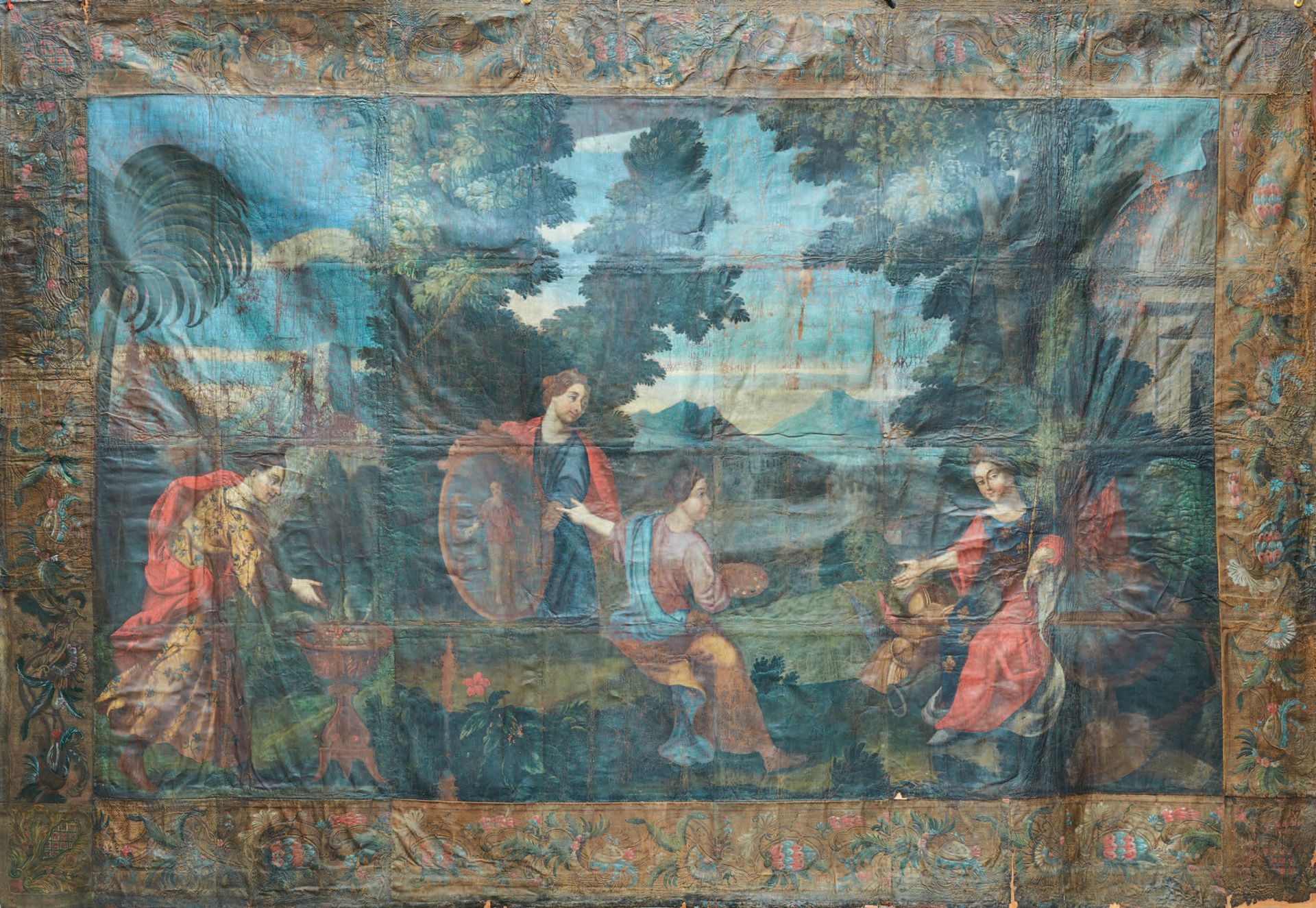Description
Rare and important hanging in painted leather partly embossed to the glory of Marie de Medici. On the right, the Queen as Pallas-Athena is seated surrounded by trophies holding the sceptre with her left hand; in front of her, in the centre, a painter, with a palette in one hand, points to an oval painting shown by another young woman representing the allegory of Justice with the scales; on the left, a woman, dressed in a yellow dress with a pattern of flowers, is trying to extinguish the glowing embers of a brazier. Rhône Valley, Avignon, Boissier family workshop, mid 17th century Height: 298 cm - Length: 424 cm (some wear and tear, especially on the left side, folds and restorations) Provenance: Former Maurice Fenaille collection, Paris Special thanks to Jean-Pierre Fournier for his help with the iconography of this large hanging and the geographical location of its production. This large hanging is one of the rare testimonies to leather painting from the French workshops of the 17th century. The art historian Jean-Pierre Fournet, author of a remarkable work on gilded leathers, has recognized in the borders motifs more specifically used by the Avignon workshops, such as a large polychrome flower evoking the coniferous leuzée and acorns resting in a shell. The naivety of the painting is reminiscent of the work of a cartoonist-painter, who was responsible in the tapestry workshops for making large canvases that served as models for the execution of the weaving to be carried out. In her red dress and her fleurdelisé mantle, the figure of Marie de Médicis is reminiscent of the famous portrait of the triumphant queen painted by Rubens for his Palais du Luxembourg. Here, Marie de Medici is represented more as Pallas Athena, goddess of wisdom and the arts, than as Bellona, goddess of war. The presence of female allegories, the four cardinal virtues, sheds light on this message. Originally, they were supposed to be four, the Force placed at the extreme left, surmounted by a lion standing on a pedestal, having disappeared, victim of a cutting to reserve the passage of a door. However, in the center, we can recognize Prudence, whose attribute is usually a mirror that she holds up. Here the artist has skilfully introduced Justice, instead of the reflection of the Queen's portrait; Temperance, another cardinal virtue, is pouring water over the embers of a stove, showing how to put out the fires of lust. The highlighted woman holding her palette personifies Art to indicate that Marie de Medici was reputed to be a great protector of the arts. Book consulted: J.P. Fournet, Cuirs dorés " Cuirs de Cordoue " - Un art européen, Ed. Monelle Hayot, 2019.
105
Rare and important hanging in painted leather partly embossed to the glory of Marie de Medici. On the right, the Queen as Pallas-Athena is seated surrounded by trophies holding the sceptre with her left hand; in front of her, in the centre, a painter, with a palette in one hand, points to an oval painting shown by another young woman representing the allegory of Justice with the scales; on the left, a woman, dressed in a yellow dress with a pattern of flowers, is trying to extinguish the glowing embers of a brazier. Rhône Valley, Avignon, Boissier family workshop, mid 17th century Height: 298 cm - Length: 424 cm (some wear and tear, especially on the left side, folds and restorations) Provenance: Former Maurice Fenaille collection, Paris Special thanks to Jean-Pierre Fournier for his help with the iconography of this large hanging and the geographical location of its production. This large hanging is one of the rare testimonies to leather painting from the French workshops of the 17th century. The art historian Jean-Pierre Fournet, author of a remarkable work on gilded leathers, has recognized in the borders motifs more specifically used by the Avignon workshops, such as a large polychrome flower evoking the coniferous leuzée and acorns resting in a shell. The naivety of the painting is reminiscent of the work of a cartoonist-painter, who was responsible in the tapestry workshops for making large canvases that served as models for the execution of the weaving to be carried out. In her red dress and her fleurdelisé mantle, the figure of Marie de Médicis is reminiscent of the famous portrait of the triumphant queen painted by Rubens for his Palais du Luxembourg. Here, Marie de Medici is represented more as Pallas Athena, goddess of wisdom and the arts, than as Bellona, goddess of war. The presence of female allegories, the four cardinal virtues, sheds light on this message. Originally, they were supposed to be four, the Force placed at the extreme left, surmounted by a lion standing on a pedestal, having disappeared, victim of a cutting to reserve the passage of a door. However, in the center, we can recognize Prudence, whose attribute is usually a mirror that she holds up. Here the artist has skilfully introduced Justice, instead of the reflection of the Queen's portrait; Temperance, another cardinal virtue, is pouring water over the embers of a stove, showing how to put out the fires of lust. The highlighted woman holding her palette personifies Art to indicate that Marie de Medici was reputed to be a great protector of the arts. Book consulted: J.P. Fournet, Cuirs dorés " Cuirs de Cordoue " - Un art européen, Ed. Monelle Hayot, 2019.
